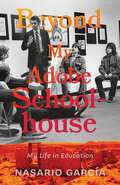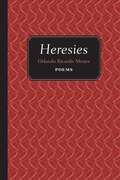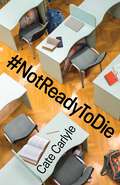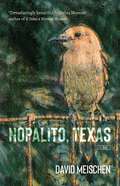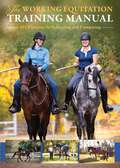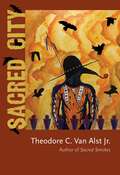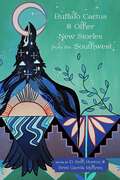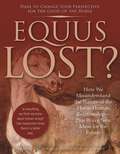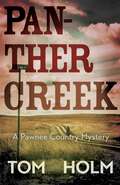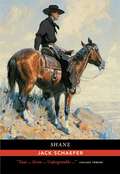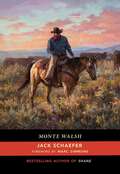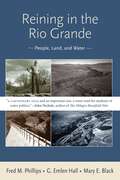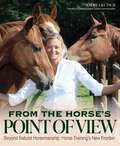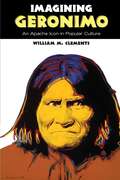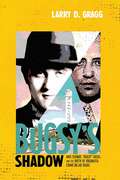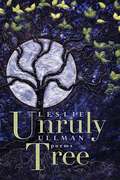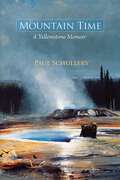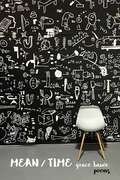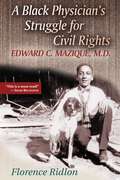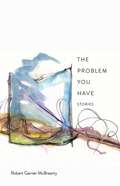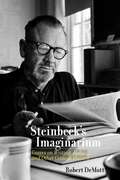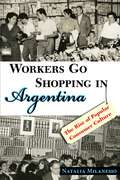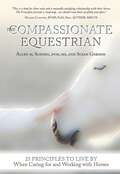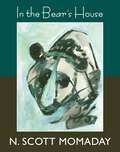- Table View
- List View
Beyond My Adobe Schoolhouse: My Life in Education
by Nasario GarcíaNasario García dedicated his life to educating others in a variety of settings, including universities and prisons. A native of rural New Mexico and a beloved writer and folklorist, in Beyond My Adobe Schoolhouse García reflects on his experiences of being educated and of being an educator. He takes readers from his childhood in a one-room schoolhouse through graduate school and to universities and other settings in Pennsylvania, Illinois, Colorado, and New Mexico, all places in which he spent time teaching in various capacities. Beyond My Adobe Schoolhouse is a love song to education and a reminder to everyone that it is possible to find a life, love, and purpose beyond the circumstances into which they were born.
Heresies: Poems (Mary Burritt Christiansen Poetry Series)
by Orlando Ricardo MenesHeresies is an invocation of Latin American and Caribbean culture, history, and spirituality. Through free verse and poetic forms, the collection is visually charged and sonically rich. The poems incorporate history, legend, and magical realism to create a cross-cultural baroque feeling. Heresies is witty, probing, transgressive, and carnivalesque.
#NotReadyToDie
by Cate Carlyle#NotReadyToDie is a gripping novel that follows the harrowing experience of a group of high school students facing a school shooter. As they struggle to survive, the students must rely on their wits, bravery, and cooperation to outsmart the shooter and escape with their lives. This heart-pounding tale sheds light on the importance of unity and support in the face of perilous situations. Written for young adults, this book delivers a powerful and timely message about resilience and the strength found in coming together in the face of adversity. With its compelling storyline and relatable characters, the high school shooting survival story is a must-read for young readers.
Nopalito, Texas: Stories (Lynn and Lynda Miller Southwest Fiction Series)
by David MeischenIn this stunning debut story collection, everyone's got the blues but nobody is willing to sing it. Evelyn Smith, Candace Lambert, and Dorene Wahrmund chafe against rigid small-town expectations. Others in hardscrabble Nopalito find themselves fenced in--an aging gay liquor store owner estranged among his neighbors, a mother and son bound by mutual resentment, two neighboring farm boys attracted to each other. Their stories are driven by desperation, rarely spoken, that troubles the community's inhabitants as it nudges them toward connection, toward moments of hope. Meischen draws these characters with a tenderness that belies the hardness of their lives.
Working Equitation Training Manual
by Ali KermeenThe only book available devoted to learning and perfecting working equitation obstacles. Working equitation is a competitive equestrian sport that originated in Europe, with the first European Championship held in 1996. It quickly gained a fanbase for its beauty and its focus on classical horsemanship ideals and developing handiness under saddle. In 2004 the World Association for Working Equitation (WAWE) was established, and today, many countries have their own national organizations for governing working equitation competitions, including the United States—the USAWE was formed in 2020. Heralding the advent of a brand-new way to pursue and demonstrate horse-and-rider connection, working equitation competitor and trainer Ali Kermeen has written a much-needed reference for preparing both horse and rider to participate. The Working Equitation Training Manual provides a one-of-a-kind progressive training system to those new to the sport. Lessons focus on developing confidence with the obstacle phases of working equitation while incorporating dressage principles. The elements of each obstacle are broken down and then brought back together in step-by-step exercises that: Prepare horse and rider to perform an obstacle properly. Introduce horses and riders to competition obstacles. Help improve and polish an obstacle's execution. With clear diagrams and color photographs, a helpful glossary of terms to help those unfamiliar with working equitation terminology, and variations and benefits for every exercise, readers are provided an appealing introduction to an exciting option for adding diversity to daily training, as well as showing and competing in other sports. &“I started teaching these skills to all my students, regardless of their riding discipline,&” says Ali. &“These working equitation exercises help my riders excel at dressage, endurance, trail riding, pony clubbing, eventing, jumping, gaited horses, groundwork, Cowboy Dressage, and breed shows.&” The Working Equitation Training Manual promises to do the same for you.
Sacred City
by Theodore C. Van AlstChicago: home to urban Indians and immigrants and working folks and the whole gamut of people getting by in a world that doesn&’t care whether they do so or not. Sacred City is an incomparable follow-up to Van Alst&’s award-winning debut collection, Sacred Smokes. Our young narrator now heads deeper into the heart of the city and himself, accompanied by ancestors and spirits who help him and the reader see that Chicago was, is, and always will be Indian Country. Part love song and part lament, Sacred City explores what options are available to an intelligent, smart-assed young man who was born poor and grew up in a gang. Van Alst&’s skillful storytelling takes us on a journey where Chicago will never seem the same.
Buffalo Cactus and Other New Stories from the Southwest
by D. Seth Horton and Brett Garcia MyhrenRevealing the Southwest as home to some of the most entertaining writers in twenty-first century fiction, this collection features a wonderfully diverse array of authors, including Alberto Álvaro Ríos, Ron Carlson, José Skinner, Tacey M. Atsitty, and Kirstin Valdez Quade.
Equus Lost?
by Francesco De GiorgioIn the 1980s, the world of riding, training, and competing with horses took a major turn with the spread of natural horsemanship, which at its most basic foundation rejects the use of abusive techniques and relies on methods derived from understanding the dynamics of free-roaming horse herds. Since then, equestrians across disciplines have incorporated elements of natural horsemanship into their work. But despite what was certainly an advancement in human-equine interaction that has improved the lives of many horses, Italian animal behaviorists Francesco de Giorgio and José Giorgio-Schoorl dare to now ask,What if much of what we think we know about horses is, in fact, wrong? What if the premise of herd hierarchy is a myth? What if conditioning the horse's behavior in the ways we've grown accustomed is undercutting his potential for development? What if there is another—better—level of partnership to which we can aspire?Their provocative book takes us into a dimension where we shed our assumptions of leadership, dominance, and control, convincingly showing a way forward that acknowledges that a horse, when allowed, is driven by his own inner motivation to explore and understand the world around him, including his relationship with humans.
Panther Creek: A Pawnee Country Mystery (Native Edge Series)
by Tom HolmJ. D. Daugherty and Hoolie Smith return in this riveting 1928 mystery. A sadist is preying on young women, especially Native American girls. He murders them and dumps their bodies by two creeks—one near Pawnee and one near Claremore—both named Panther Creek.Hoolie, his family, and his friend John Tall Soldier have driven to Pawnee, Oklahoma, to visit the Shield Chiefs. After Mary Shield Chief goes missing, Hoolie and John find her body in the bed of Panther Creek. Hoolie&’s family begin a hunt for the murderer.Meanwhile, J. D. has a new partner in Liz Shelby, daughter of oil man Big Bill Shelby. Together they search for the missing daughter of another wealthy Tulsa family, but they soon find her body at Panther Creek near Claremore.Their cases colliding, Daughtery, Shelby, and the Smith clan find themselves up against a wily killer and running against time to bring him to justice.
Shane
by Jack SchaeferIn this true Western classic Jack Schaefer tells the story of a mysterious stranger who finds himself in the Wyoming Territory joining local homesteaders in their fight to keep their land and avoid the intimidating tactics of cattle driver Luke Fletcher. While trying to leave his gunslinging days behind him, the mysterious stranger, Shane, is tested by Fletcher and his men. In Shane, Schaefer executes a perfect Western narrative while exploring the overarching themes of virtue, the human condition, and a man&’s search for self.
Monte Walsh
by Jack SchaeferOriginally published in 1963, Monte Walsh continues to delight readers as a Western classic and popular favorite. The novel explores the cowboy lives of Monte Walsh and Chet Rollins as they carouse, ride, and work at the Slash Y with Cal Brennan. As the West changes and their cowboy antics are challenged, the two must part ways to pursue new ways of life. Chet marries and goes on to become a successful merchant and then a politician, while Monte can only find solace in continuing the cowboy&’s way of life until the very end.
Reining in the Rio Grande: People, Land, and Water
by Fred M. Phillips G. Emlen Hall Black E. MaryThe Rio Grande was ancient long before the first humans reached its banks. These days, the highly regulated river looks nothing like it did to those early settlers. Alternately viewed as a valuable ecosystem and life-sustaining foundation of community welfare or a commodity to be engineered to yield maximum economic benefit, the Rio Grande has brought many advantages to those who live in its valley, but the benefits have come at a price.This study examines human interactions with the Rio Grande from prehistoric time to the present day and explores what possibilities remain for the desert river. From the perspectives of law, development, tradition, and geology, the authors weigh what has been gained and lost by reining in the Rio Grande.
From the Horse's Point of View
by Andrea KutschAn eye-opening book leading equestrians into a brave new horse world, where we train horses their way, not ours.For years, Andrea Kutsch filled stadiums with spectators as she demonstrated remarkable transformations in &“problem horses&” using the Natural Horsemanship training methods she'd learned from leaders in the field. But something was bothering her
Imagining Geronimo: An Apache Icon in Popular Culture
by William M. ClementsHis face has appeared on T-shirts, postage stamps, jigsaw puzzles, posters, and an Andy Warhol print. A celebrity and a tourist attraction who attended three World&’s Fairs and rode in President Theodore Roosevelt&’s inaugural parade, he is a character in such classic westerns as Stagecoach and Broken Arrow. His name was used in the daring military operation that killed Osama bin Laden in 2011, and rumors about the location of his skull at a Yale University club have circulated for a century. These are just a few of the ways that the Apache shaman and war leader known to Anglo-Americans as Geronimo has remained alive in the mainstream American imagination and beyond.Clements&’s study samples the repertoire of Geronimo stories and examines Americans&’ changing sense of Geronimo in terms of traditional patterns—trickster social bandit, patriot chief, sage elder, and culture hero. He looks at the ways in which Geronimo tried with mixed results to maintain control of his own image during more than twenty years in which he was a prisoner of war. Also examined are Geronimo&’s ostensible conversion to Christianity and his image in photography and literature.
Bugsy's Shadow: Moe Sedway, Bugsy Siegel, and the Birth of Organized Crime in Las Vegas
by Larry D. GraggThe story of Moe Sedway, the eponymous "shadow" to Benjamin &“Bugsy&” Siegel, from his days as Bugsy's right hand associate to his suspected role in Bugsy's unsolved disappearance, and the role Sedway played in the creation of modern Las Vegas.Early in the Prohibition era, Moe Sedway became part of the New York organized crime gang led by Meyer Lansky and Benjamin &“Bugsy&” Siegel. A loyal and highly effective operative for Siegel, Sedway eventually gained monopoly control of the race wire service in Las Vegas and also became an effective casino manager of the Las Vegas Club, El Cortez, and the Rex Club.A breach in their relationship led to rumors that Sedway had gained Lansky&’s approval for a &“hit&” on Siegel. The unsolved mystery of who murdered Bugsy in 1947 has spawned numerous theories about the identity of the hitman, but regardless of who pulled the trigger, Bugsy&’s death opened the way for Moe to flourish as his own man at last. Long overshadowed by Bugsy in the annals of organized crime in America, Moe Sedway is now at last brought out into the light in this riveting tale of the sensational life and times of one of Vegas&’s most mysterious and little-known figures.
Unruly Tree: Poems (Mary Burritt Christiansen Poetry Series)
by Leslie UllmanThe cryptic prompts—fragments, really—of Brian Eno&’s and Peter Schmidt&’s Oblique Strategies unveiled themselves to Leslie Ullman as rough translations from an obscure language. As an experiment, Ullman used each one as a poem title, and in doing so she accessed a thrill of freedom, uncertainty, and propulsion beyond her own familiar patterns and landscapes. In the process, she found herself exploring the literary, visual, and musical arts from angles that had never occurred to her before.Unruly Tree showcases the most successful of Ullman&’s play, and the result is a marvelous work by a poet at the height of her craft. At its heart this book is about process itself—even when it applies to experiences outside the arts—and about reclaiming an inner freedom many of us lose in our lives as adults in these noisy, rancorous times.
Mountain Time: A Yellowstone Memoir
by Paul SchulleryMountain Time, a thoughtful and often moving work, is not only about Yellowstone as a superb sample of American wildness, . . . but also about a man named Paul Schullery and his relationship to it. This fact gives the book much richness and power, for Schullery comes across clearly as a caring, observant, undogmatic person whose reasonable and intelligent opinions are reinforced by plenty of facts. In a certain mood, it is possible to wish (vainly) that people of his civilized caliber were the only ones allowed to open their mouths very widely on any subject that really matters, as Yellowstone definitely does.--John Graves, author of Goodbye to a River and From a Limestone LodgePaul has pushed outdoor writing to new limits. I pay him the highest compliment I can: I wish I had written Mountain Time.--Lionel Atwill, Sports Afield
Detonography: The Explosive Art of Evelyn Rosenberg
by Evelyn RosenbergArtist Evelyn Rosenberg invented a remarkable technique to make sculpture by forming metal with plastic explosives. After many months of experiments in the mid-1980s with an Israeli explosives engineer, she discovered how to refine this unique process to make large-scale, intricately designed works of art and named the new art form Detonography. Working in the New Mexico desert, near where the first atomic bomb was tested at the Trinity Site, she transforms powerful weapons of destruction into tools of creation.In this book, the first to showcase her work, she describes the history and genesis of Detonography and explains from conception to installation how a piece of explosive art is made. Her method is documented step by step with the richly detailed photography of John Trotter, a personal history, and an essay by Gideon Sivan, the explosives expert whose technical work served as Rosenberg&’s original inspiration.
MEAN/TIME: Poems (Mary Burritt Christiansen Poetry Series)
by Grace BauerBauer&’s newest collection is an exploration of time: how we perceive it and its passing, how we use language to describe the lived experience that time informs, and the transformations we undergo during its passing.
A Black Physician's Struggle for Civil Rights: Edward C. Mazique, M.D.
by Florence RidlonThis powerful biography traces the career of an African American physician and civil rights advocate, Edward Craig Mazique (1911–1987), from the poverty and discrimination of Natchez, Mississippi, to his status as a prominent physician in Washington, DC. This moving story of one man&’s accomplishments, in spite of many opposing forces, is also a chapter in the struggle of African Americans to achieve equality in the twentieth century.At a time when black people were being denied entry into the American Medical Association and were not permitted to join the staffs of most hospitals, Dr. Mazique was the president of the Medico-Chirurgical Society and the National Medical Association. Dr. Mazique worked closely with Martin Luther King Jr., Presidents John F. Kennedy and Lyndon B. Johnson, and black physicians to expand the availability of health care. Much of this story is in Dr. Mazique&’s own words, taken from interviews with the author. What emerges from this biography is a picture of an exceptional but very human man who, despite discrimination and repression, excelled beyond all expectations.
The Problem You Have: Stories (Lynn and Lynda Miller Southwest Fiction Series)
by Robert Garner McBreartyThe Sisyphean characters in The Problem You Have may not be pushing a giant rock up a hill, but they are unlikely to ever get where they are going. Yet despite knowing that, they push on and work with graceful resignation. In McBrearty’s newest collection a diverse group of characters encounter turning points. A minor criminal seeking warmth on a frigid night climbs through a farmhouse window to discover more than he ever expected. A dying soldier recalls the man he left behind. In one horrible afternoon, a college professor realizes the only sanctuary is love. An over-the-hill pitcher refuses to get off the mound. A young couple meets the couple they never want to become. Some of the stories hold dark themes, yet McBrearty masterfully infuses the work with humor and compassion, rendering the characters within them relatable. Even with themes of loss or what might have been, the collection sings notes of what might yet be, for both the characters and the reader.
Steinbeck's Imaginarium: Essays on Writing, Fishing, and Other Critical Matters
by Robert DeMottIn Steinbeck&’s Imaginarium, Robert DeMott delves into the imaginative, creative, and sometimes neglected aspects of John Steinbeck's writing. DeMott positions Steinbeck as a prophetic voice for today as much as he was for the Depression-era 1930s as the essays explore the often unknown or unacknowledged elements of Steinbeck&’s artistic career that deserve closer attention. He writes about the determining scientific influences, such as quantum physics and ecology, in Cannery Row and considers Steinbeck&’s addiction to writing through the lens of the extensive, obsessive full-length journals that he kept while writing three of his best-known novels—The Grapes of Wrath, The Wayward Bus, and East of Eden. DeMott insists that these monumental works of fiction all comprise important statements on his creative process and his theory of fiction writing. DeMott further blends his personal experience as a lifelong angler with a reading of several neglected fishing episodes in Steinbeck&’s work. Collectively, the chapters illuminate John Steinbeck as a fully conscious, self-aware, literate, experimental novelist whose talents will continue to warrant study and admiration for years to come.
Workers Go Shopping in Argentina: The Rise of Popular Consumer Culture
by Natalia MilanesioIn 1951 an Argentine newspaper announced that the standard of living of workers in Argentina was &“the highest in the world.&” More than half a century later, Argentines still look back to the mid-twentieth century as the &“golden years of Peronism,&” a time when working people, who had struggled to make ends meet a few years earlier, could now buy ready-made clothing, radios, and even big-ticket items like refrigerators. Milanesio explores this period marked by populist politics, industrialization, and a fairer distribution of the national income by analyzing the relations among consumers, consumer goods, manufacturers, advertising agents, and Juan Domingo Perón&’s government (1946–1955).Combining theories from the anthropology of consumption, cultural studies, and gender studies with the methodologies of social, cultural, and oral histories, Milanesio shows the exceptional cultural and social visibility of low-income consumers in postwar Argentina along with their unprecedented economic and political influence. Her study reveals the scope of the remarkable transformations fueled by the new market by examining the language and aesthetics of advertisement, the rise of middle- and upper-class anxieties, and the profound changes in gender expectations.
Compassionate Equestrian
by Susan Gordon Allen SchoenThis marvelous book, borne of a unique collaboration between Dr. Allen Schoen—a world-renowned veterinarian and author—and trainer and competitor of many years Susan Gordon, introduces the 25 Principles of Compassionate Equitation. These Principles, conceived by Dr. Schoen and Gordon, are a set of developmental guidelines, encouraging a level of personal awareness that may be enacted not only through the reader's engagement with horses, but can be extended to all humans and sentient beings he or she encounters. The 25 Principles share stories and outline current, peer-reviewed studies that identify and support methods of training, handling, and caring for horses that constitute a safe, healthy, non-stressful, and pain-free environment. Through their Compassionate Equestrian program, the authors encourage all involved in the horse industry to approach training and handling with compassion and a willingness to alleviate suffering. By developing deeper compassion for their own horses, and subsequently, all equines, equestrians transcend their differences in breed preferences, riding disciplines, and training methodologies. This leads to the ability to empathize and connect more closely with the &“global collective&” of horses and horse people. In doing so, a worldwide community of compassionate equine practitioners and horse owners will emerge, which will not only benefit the horses: People involved with horses are found in many influential segments of society and have the potential to affect wide circles of friends, acquaintances, and co-workers from every walk of life. These are simple changes any horse person can make that can have a vast impact on the horse industry and society as a whole.
In the Bear's House
by N. Scott MomadayLet me say at the outset that this book is not about Bear (he would be spoken of in the singular and masculine, capitalized and without an article), or it is only incidentally about him. I am less interested in defining the being of Bear than in trying to understand something about the spirit of wilderness, of which Bear is a very particular expression. . . . Bear is a template of the wilderness.--from the IntroductionSince receiving the Pulitzer Prize in 1969 for his novel House Made of Dawn, N. Scott Momaday has had one of the most remarkable careers in twentieth-century American letters. Here, in In the Bear's House, Momaday passionately explores themes of loneliness, sacredness, and aggression through his depiction of Bear, the one animal that has both inspired and haunted him throughout his lifetime.With transcendent dignity and gentleness, In the Bear's House celebrates Momaday's extraordinary creative vision and evolution as one of our most gifted artists.
